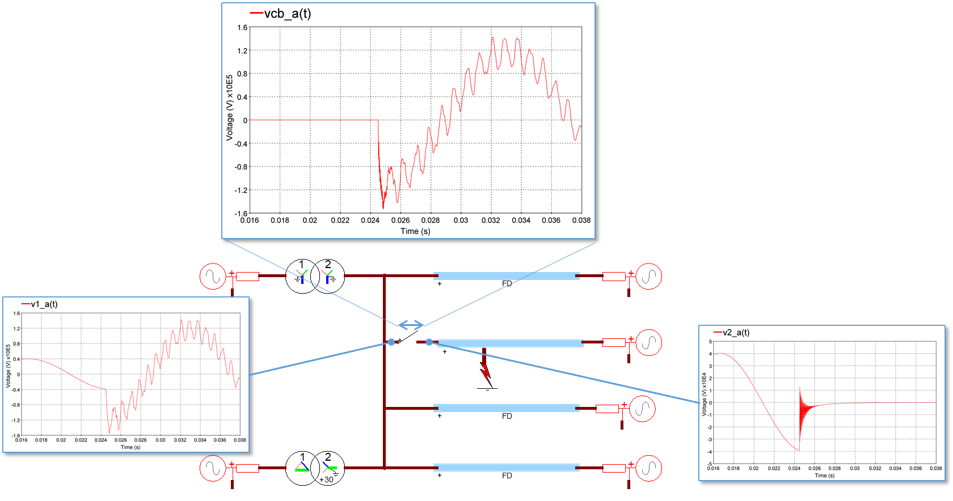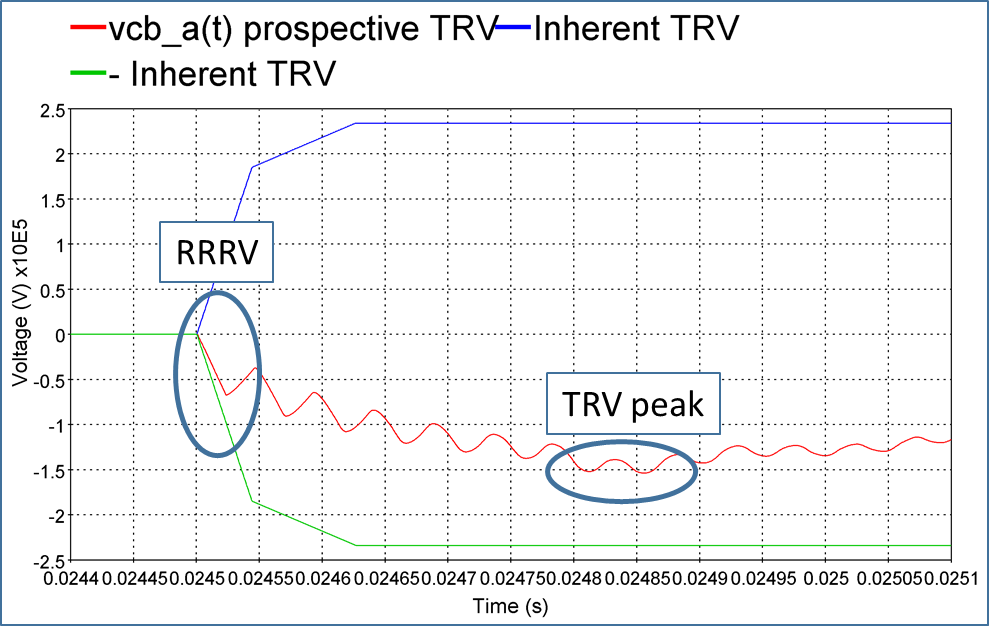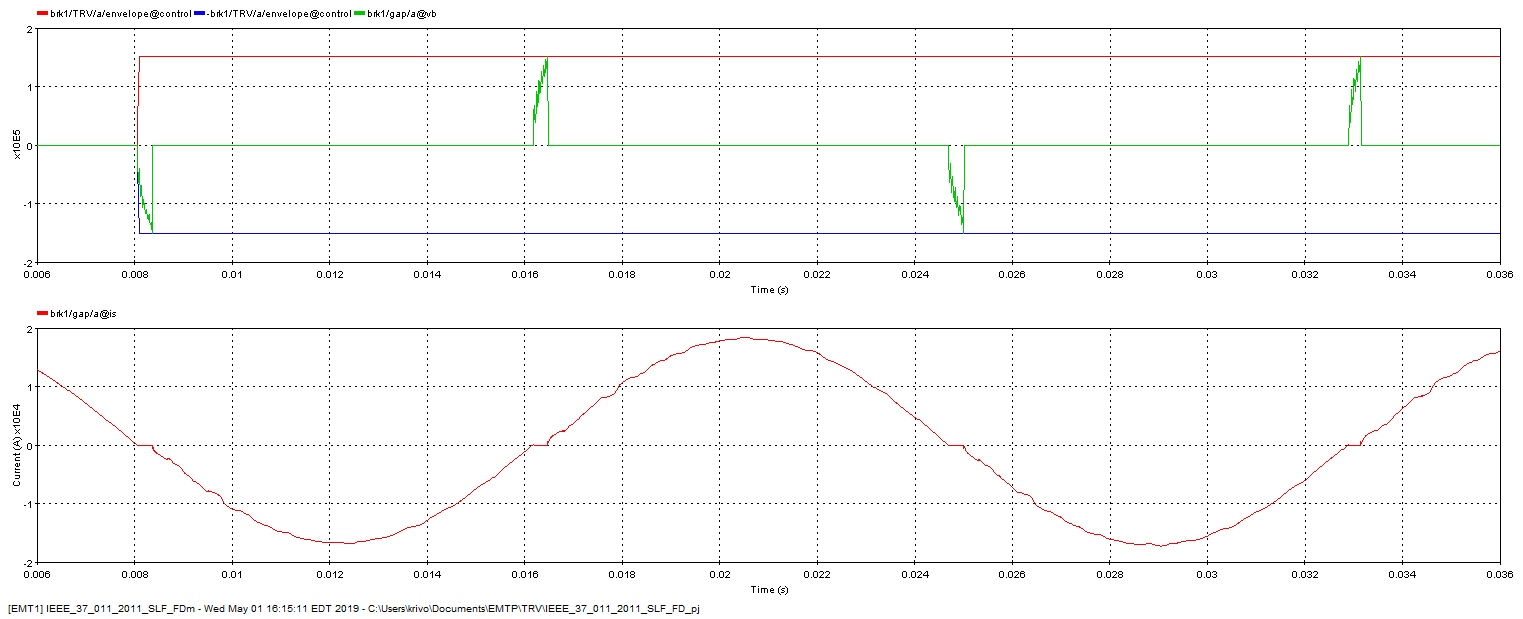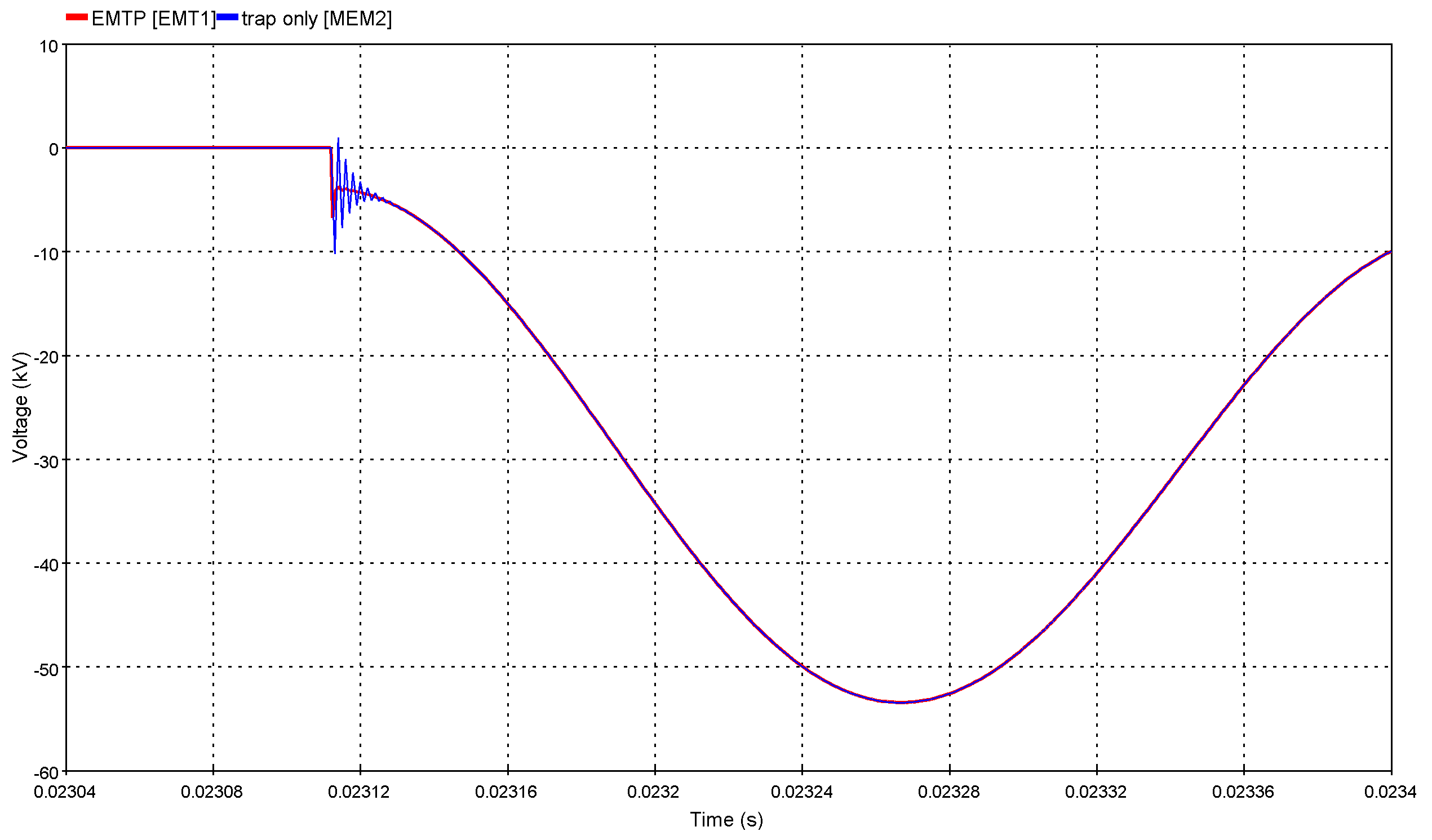Definition
IEEE C37.011 - The Transient Recovery Voltage (TRV) is the voltage that appears across the terminals of a circuit breaker after a current interruption. This voltage may be considered in two successive time intervals: one during which a transient voltage exists (TRV), followed by a second during which a power-frequency voltage alone exists.
Below is an example of the TRV for 145kV transmission line system. The TRV follows a transmission line fault clearance.

TRV is a consequence of different voltage response of the circuits on the source side and load side of the circuit breaker. This difference creates the TRV across the breaker terminals.
The standards covering TRV analysis are:
- IEEE C37.011-2011: IEEE Guide for the Application of Transient Recovery Voltage for AC High-Voltage Circuit Breaker
- IEEE C37.06-2009: IEEE Standard for AC High-Voltage Circuit Breakers Rated on a Symmetrical Current Basis - Preferred Ratings and Related Required Capabilities for Voltages Above 1000
- IEC 62271-100: High-Voltage switchgear and control gear – Part 100: Alternating-current circuit-breaker. Edition 2.0, 2008-04
Why TRV must be studied?
The TRV appearing across a circuit breaker while it is opening will challenge the longitudinal voltage withstand of the gap between the breaker poles. If the system TRV reaches the gap withstand voltage, a longitudinal breakdown will take place. This is called a reignition if the breakdown occurs before a quarter cycle following the current interruption, and a restrike if it occurs after.
Restrikes must be avoided by design, and re-ignition minimized, as they can create hot-spots in the circuit breaker and high-frequency transients in the circuit, the worst cases being if the circuit-breaker is simply not able to interrupt the current, or if the successive breakdowns create a voltage escalation.
Below is an example of an unsuccessful breaker opening in a 13.8kV system, with multiple restrikes and voltage escalation.

What are the main steps of a TRV study?
1. System modeling: The system must be modeled for frequencies ranging from the fundamental to few kilohertz. For the most part, and especially for conductors, frequency-dependent modeling is required.
2. Simulation of worst-case scenarios: depending of the system, some clearing scenarios will be more challenging for the circuit-breaker. For example, 3-phase ungrounded faults are very often the most challenging events to clear, especially if they occur at the secondary of a series-reactor or a transformer. For lines, short-line-faults (single-phase to ground) and 3-phase terminal faults are the worst cases. The outcomes of the worst-case scenario simulations are the prospective TRVs.
3. Comparison of the prospective TRVs (obtained by simulation) with the breaker inherent TRV (obtained in lab by standardized tests): the prospective TRV is superimposed with the breaker inherent TRV envelop which is built with 2 or 4 parameters and depends on:
- The breaker class
- The rated voltage
- The rated short-circuit current
- The type of fault cleared during the studied event
- The short-circuit current cleared during the studied event
Both the TRV magnitude and its initial slope (known as the Rate of Rise of Recovery Voltage or RRRV) must be inside the inherent TRV envelop, considering a safety margin.
The following figure shows a 145kV system prospective TRV obtained during the simulation of a 13kA short-line single-phase-to-ground and superimposed with a 4-parameter inherent TRV of a circuit breaker rated 30kA and which class is >100kV effectively earthed.

In which circuit configuration TRV analysis must be done?
TRV occurs anytime a circuit-breaker interrupts a current. However, only breakers rated 3.6kV and above are concerned.
TRV studies are typically performed for the following cases:
- Breakers disconnecting transmission lines: In this case, two cases are simulated:
o A short-line single-phase-to-ground fault, which produces the more severe RRRV

o A terminal 3-phase ungrounded fault, which produces the highest TRV

- Breakers disconnecting reactors
- Transformer limited faults

- Induction motor tripping during start-up
- Synchronous generator tripping
- Capacitor-bank de-energization
Why choose EMTP® for TRV analysis?
EMTP® is the most versatile platform for TRV analysis, with built-in standards and functionalities that allow to effortlessly compare the system prospective TRV, obtained by simulations, and the breaker inherent TRV envelope.
Here are some major advantages:
- The inherent TRV envelop can be either user-defined or follows IEC and IEEE standards. EMTP® also precisely calculates the inherent TRV envelope parameters according to the simulation fault current by interpolation of the standard tests T10, T30, T60 and T100.

EMTP® Circuit Breaker model for TRV
- Frequency dependent transmission line modeling allows EMTP® to precisely capture the voltage wave propagation/reflection (travelling waves) that can significantly increase the system RRRV.
- Breaker stray-capacitance has a very important impact on the TRV. A large database of value is available in EMTP®.
- Restrikes/prestrikes and re-ignitions can be simulated with the advanced TRV circuit breaker model.

EMTP® Results for a TRV with multiple re-ignitions, including the withstand envelope/voltage and current
- Statistical approach to TRV simulation allows you to effortlessly assess the impact of different switch tripping instants on the TRV waveforms and determine the worst-case scenario.
- EMTP® scripting allows you to automatically test various fault cases and loading conditions.

EMTP® circuit with a breaker model for TRV analysis
- Numerical stability: most EMT-type programs use trapezoidal integration for solving network equations. Trapezoidal integration is fast and precise, but it is unstable during discontinuities. The instabilities are typically damped by artificial resistances. This causes a problem during TRV analysis because it can make the RRRV determination very difficult.
EMTP®, which also uses trapezoidal integration, solves this problem by using the backward Euler integration method during discontinuities and reduces the integration time-step when they occur.
Below is an example of the TRV results given by EMTP® compare to a solver using trapezoidal integration with numerical damping resistances.

